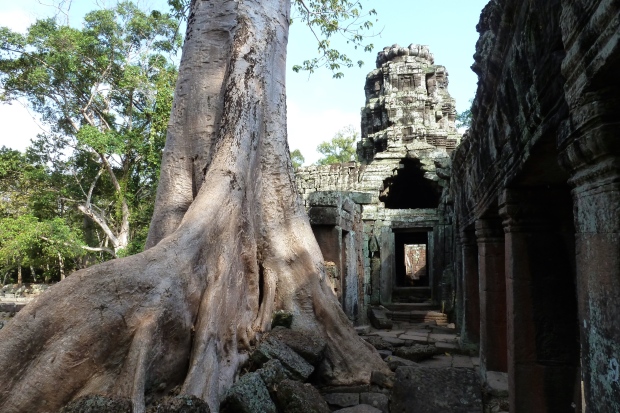On our 2nd day in Angkor Archeological Park, we explored some temples that are further out from the main circuit, and therefore the crowds were thinner too. Many of these temples are in an area known as East Baray (a large ancient reservoir), on the eastern side of the Park.
Banteay Kdei. We really enjoyed this temple, and had it almost completely to ourselves. It is a late 12th century temple, and is close to Ta Prohm, both geographically and style-wise.

A perfect picture-window section of Banteay Kdei.
Parts of the temple are a jumble of blocks and other parts you wonder how they’re still standing.

It amazes me that you can walk around these parts of Banteay Kdei!
It was poorly constructed using a poor quality of sandstone, but who can complain after nearly 1,000 years.

Another view of Banteay Kdei.
East Mebon. This temple was originally a man-made island, rising up out of the middle of the ancient East Baray reservoir, which is now dry. It is a late 10th century temple, and was dedicated to Hindu god Shiva, and is somewhat similar in style to Pre Rup, below.

East Mebon. This temple’s layout makes it difficult to get a good photo.
Pre Rup. This is another huge (and tall) state temple (meaning it defined a king’s capital city) and was built in the late 10th century, just a decade later than East Mebon. It has several imposing towers, and is another “mountain in stone” like Bayon.

A view of Pre Rup.

The courtyard around Pre Rup.
Banteay Samre. This mid 12th century temple is a bit isolated, at the eastern edge of Angkor Park, and hence is one of the least visited temples in the Park.

The walls, entrance and courtyard at Banteay Samre.

The main temple structure at Banteay Samre. The similarities to Angkor Wat are evident.
Banta Samre is surrounded by a large wall and is complete, meaning there are no ruined sections as a result of a well-planned reconstruction, and it has many well-preserved carvings. We had this temple to ourselves.
Ta Som. Another of my favorite temples, in the style of Bayon, late 12th century. This temple is north of East Mebon, but makes sense to visit after Banteay Samre if you continue a counter-clockwise route from south to north. It is a small temple, with the entrances being the most picturesque parts.

The east entrance into Ta Som (note the faces in the tower behind the tree).

Inside Ta Som temple.
Neak Pean. This is a very unique small 12th century structure, located on a island, with eight pools surrounding it. For part of the year the pools are dry.

Neak Pean temple.

The marshy reservoir surrounding the island temple of Neak Pean.
The waters were thought to have healing properties. You walk out on a boardwalk across a strange looking shallow reservoir to get to the temple on the island.
Preah Khan. Another great, romantic late 12th century temple. From an interest standpoint, I would put it in the same class as Ta Prohm (See Day 1 post).

Exterior view of Preah Khan.
This is a large temple, with many different courtyards, and was the residence of King Jayavarman VII while his palace was being constructed in Angkor Thom.

View of carving detail at Preah Khan.

Interior hallway at Preah Khan.

This structure at Preah Khan is unusual, having round columns. It may have been constructed at a later date.
Photo-wise, Preah Khan is interesting from multiple angles, with tree roots, vines and tumbled stone everywhere.
Beng Melea. Technically we visited Beng Melea on Day 3, but who is counting! This is an early 11th century temple, about 60 km southeast of Siem Reap. We hired a taxi for the round trip, and it cost about $50 USD. I had thought that since we were going so far out of Siem Reap, it would be pretty quiet. However, this temple is now on the tourist map, and there were a number of smaller tour buses here. Even so, it is still very worthwhile.

A view of Beng Melea. Much of the structure is ruined, giving it an “undiscovered” feel.

A part of Beng Melea that we had to ourselves.
Being on our own, my son and I were able to visit parts of the temple that the tour groups ignore (or don’t know about).

A section of wall at Beng Melea.

Another secluded part of Beng Melea.
Although hard to tell, this temple is in the style of Angkor Wat, and since it was constructed prior to Angkor Wat, it may have served as a prototype for that great structure.
Angkor Archeological Park and the surrounding area can mesmerize the tourist for days. If you get a chance, visit this astounding cultural and architectural gem.






























































